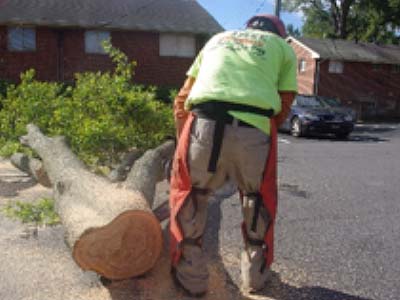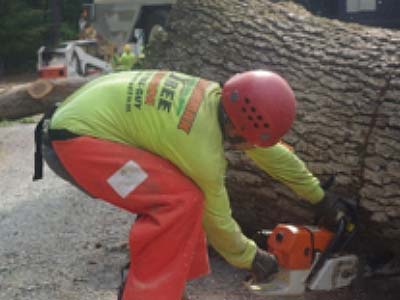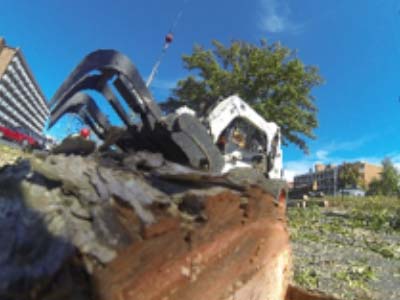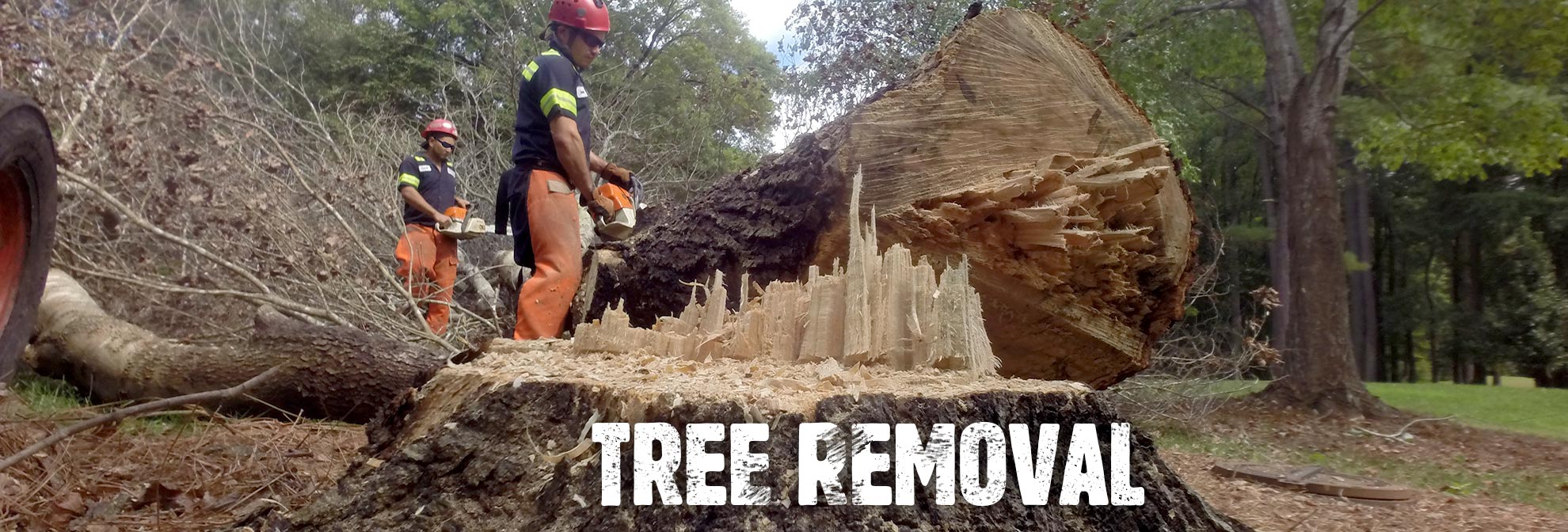
Crane Assisted Tree Removal
Emergency Tree Removal
Hazardous Tree Removal
1 MILLION TREES SAFELY
 Not many companies can say that they have safely removed over 1 million trees. Throughout the years we have removed well over 1 million unsafe, unwanted and dangerous trees. Our passion drives us to more than just remove a tree. Every single tree that we cut down, we strive to do it in the safest, best and most efficient way possible. We continually train, educate and implement new methods and practices for removing and caring for trees. Staying on the cutting edge of advancements in our industry allows us to offer you the best tree services at the best possible rates.
Not many companies can say that they have safely removed over 1 million trees. Throughout the years we have removed well over 1 million unsafe, unwanted and dangerous trees. Our passion drives us to more than just remove a tree. Every single tree that we cut down, we strive to do it in the safest, best and most efficient way possible. We continually train, educate and implement new methods and practices for removing and caring for trees. Staying on the cutting edge of advancements in our industry allows us to offer you the best tree services at the best possible rates.
We are ethical and honest. We will not recommend or suggest the removal of a tree if it is not necessary. Quite frequently companies will try to alarm clients by telling them a tree is more likely to fail when it actually has a low probability of failure. Then there are companies on the other side of the spectrum that recommend treatments, injections and pruning when they clearly are not needed. Some of these treatments can be labeled as placebos or snake oils. Our certified arborists are trained and certified to identify, asses and diagnose hazards associate with your trees. The years and years of experience that each of our arborists possess allow them to easily recognize unsafe trees and identify hazards that may cause a tree to fail. We love trees and truly appreciate them but we will never allow our passion for trees to influence our decision making process. We will always take a non-biased and systematic approach when evaluating trees for risk.
The basics of tree removal
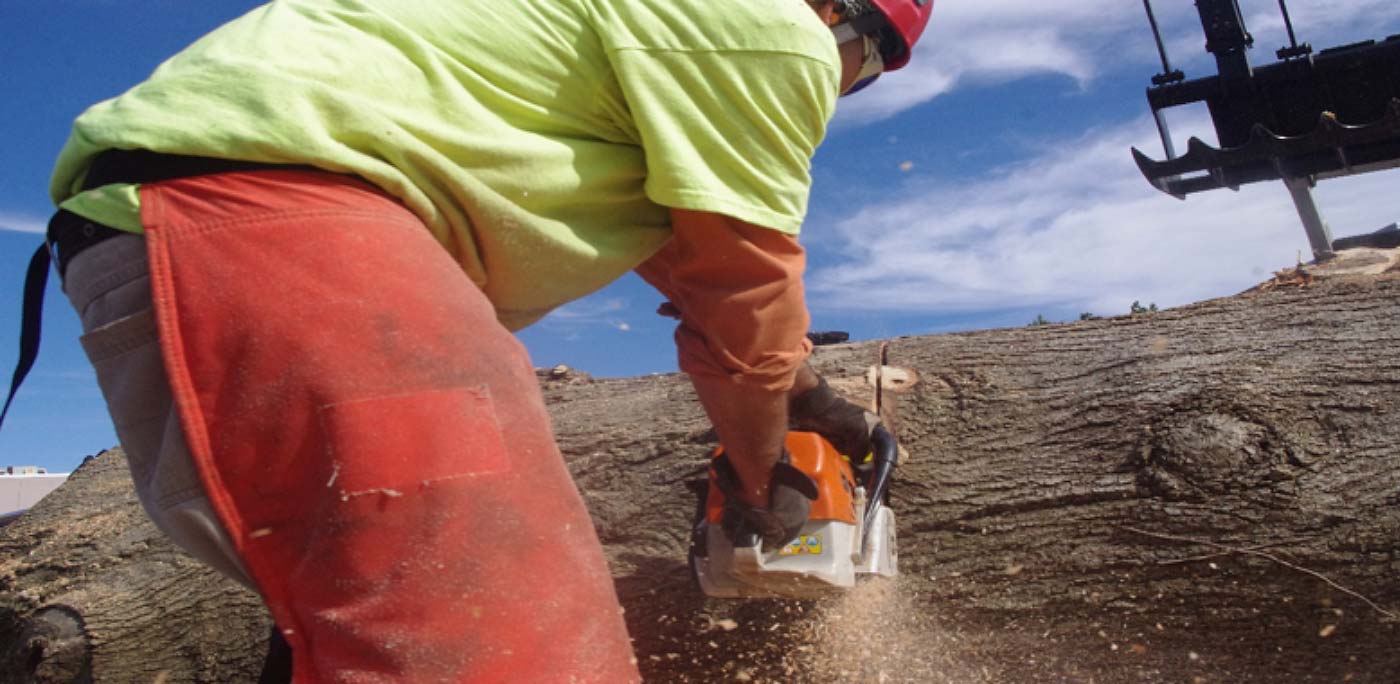
Read below to learn more about our tree removal processes.
Most of our clients know a small amount about the tree removal process and or what it looks like to safely remove a tree. There are a variety of variables that we take into consideration during the tree removal procedure. Each tree is different in its own way and utilizes different approaches. There are numerous methods of removing a tree. Each practice requires different techniques and equipment. The ensuing methods are the customary techniques used when removing trees.
Felling the entire tree.
This process is the simplest method for getting the tree on the ground. The first step in the process is to determine the height of the tree. Once the trees height is approximated the saw men will evaluate the surrounding area to decide if there is enough space to drop the tree safely. Usually, urban environments such as residential yards and neighborhood settings do not have adequate room to safely drop an entire tree. If this is the case the tree must be removed in sections. If there is enough area, the tree feller will then asses the angle of the tree, checking for symmetry to determine if the tree has a greater weight on one side than the other. He will search for any faults in the trunk, such as decay or cavities that could cause the notch to break. All these factors will help the tree cutter decide what kind of notch he needs to use and where to place it. Before the notch is made in the tree, a rope will be tied to the top of the tree that will be removed.
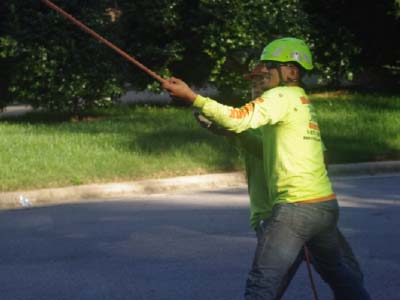
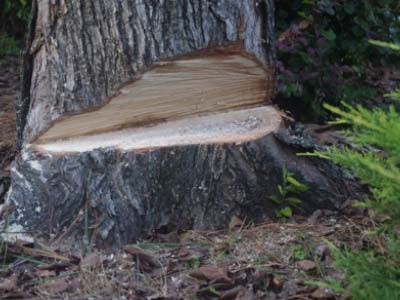

This ensures the removal crew will guide the tree in the direction needed. When the tree has been assesed and the rope is in the desired spot the cutting procedure will commence. A notch described as a wedge which will be cut to assist the tree with landing in the designated area. The final cut, more commonly known as the back cut. During this cut the direction of the fall can be changed by cutting a greater or lesser amount on one side of the trunk. The wood remaining between the back cut and the wedge is called the hinge wood. Hinge wood keeps the tree from falling for a brief second while it pulls towards the direction with a larger amount of hinge wood.
Standard climbing and lowering
This method is common for removing trees which are near structures such as buildings, powerlines, homes, and other barriers. This procedure begins like every other tree removal process, by evaluating the tree and planning the steps for removal. An experienced tree climber, like ones who are employed here at Arbormax will go through the entire tree removal process in their mind before they ever touch it. The most significant portion of planning the tree removal is locating a primary point to set your rigging from. When the rigging has been put in position the climber will remove and lower all imperative limbs. Once those limbs have been cut and only the trunk is left standing, he will then cut the trunk into appropriate lengths. In some instances, these pieces will be removed and dropped to the ground. Sometimes there is simply not enough space to drop the trunk pieces. Therefore, they will be descended with ropes. A climber must understand which direction the notch needs to be cut and distance and location of where the cut limbs and trunk need to be placed. Skilled grounds personnel have a role with the same importance as the climber. These employees must carefully guide the limb once it is cut free from the trunk. When the limb is removed the groundman controlling the rope will let it freefall for a brief moment and then cautiously decrease the fall of the limb. By doing this it will lessen the unstability of the load which is placed on the rigging point. There is always a designated landing zone for the removed branches and logs to be roped into. In some cases, the landing zone is straight below the rigging point and lowering it is sufficient. Most instances landing areas may be 20-30 feet from the rig point. The rope man must time the swing rate and descent speed precisely to hit his target. Serious consequences can occur if a ground man holds the rope for a second to long or to little. Consequences such as property damage, personal injury or even death. You should never let an unskilled tree climber climb or cut a tree for you.
Removing Tress with a Crane

Removing trees with a crane is the newest, safest and quickest way. This method is what we specialize in. When use our crane to effortlessly and gracefully remove large trees that would be a hard task to complete without. Our clients describe this method as awesome. This process begins by locating a place to set the crane up. This are is discussed with the client during the estimating process. The cranes 18×24 foot footprints of the outriggers must fit into this area. The space must also accommodate to the safe operating radius of the trees. When determining a safe operating radius, the size of the tree must be taken into consideration. Our cranes possess 140 feet of boom and jib while completely extended. To imagine this, it is approximately the height of a fifteen-story building. The height of the tree isn’t our only concern. Distance is a main concern, the farther the tree is from the crane the less weight per pick the crane can take. Generally, our operating radius is 90 ft. For trees that are smaller we can go 135 foot away from the crane. Once the crane is stet up and leveled the operator will scope the boom out and place the ball over the tree that is being removed. The cable will then be descended to the climber who is waiting at the bottom of the tree. He will the safely tie his line in and be raised to the top of the tree. Once the climber has reached the top of the tree, he will connect the cable and direct the crane operator to apply tension. Then he will repel down his rope to the predetermined area to make the cut. Once he is tied in he cuts the designated area the crane operator will lift the section that has been cut off the tree and swing it to the determined landing zone. Once the piece had been lowered into the landing zone the ground crew will remove the cable so the crane operator and climber can make the next pick. This step of the removal process is repeated until the entire tree has been removed. Please visit our Crane assisted tree removal page for more info.
Removal of debris and ground operations
The three methods above are ways to cut a tree down. We haven’t spoke on what happens once it reaches that point. When the debris hits the ground is when the real work happens. Some of the hardest working men you have ever seen come to light in this step of the tree removal process. Our employees specialize in ground operations and have been compared to angry ants running chainsaws and termites on steroids. The task they perform is often compared to that of a well-designed dance routine, one where everyone is in sync. Have you ever seen a crew take apart a tree in seconds? These guys can show you how it is done. They really know what to do when the wood hits the ground. Every piece of wood cut and removed by our company is used. 100% no exceptions. Our crew has been trained to cut everything to correct sizes so that it can be placed I the correct tuck. All branches and logs under 12 inches in diameter will go through our woodchipper and be recycled and reused as mulch. All wood over twelve inches wide will be cute into appropriate log lengths. These logs will be sent to numerous mills to be recycled into a variety of products such as paper, lumber and furniture. The yard will be raked and blown after the large debris has been removed. We take pride in what we do and always leave our clients yard cleaner than when we began.
